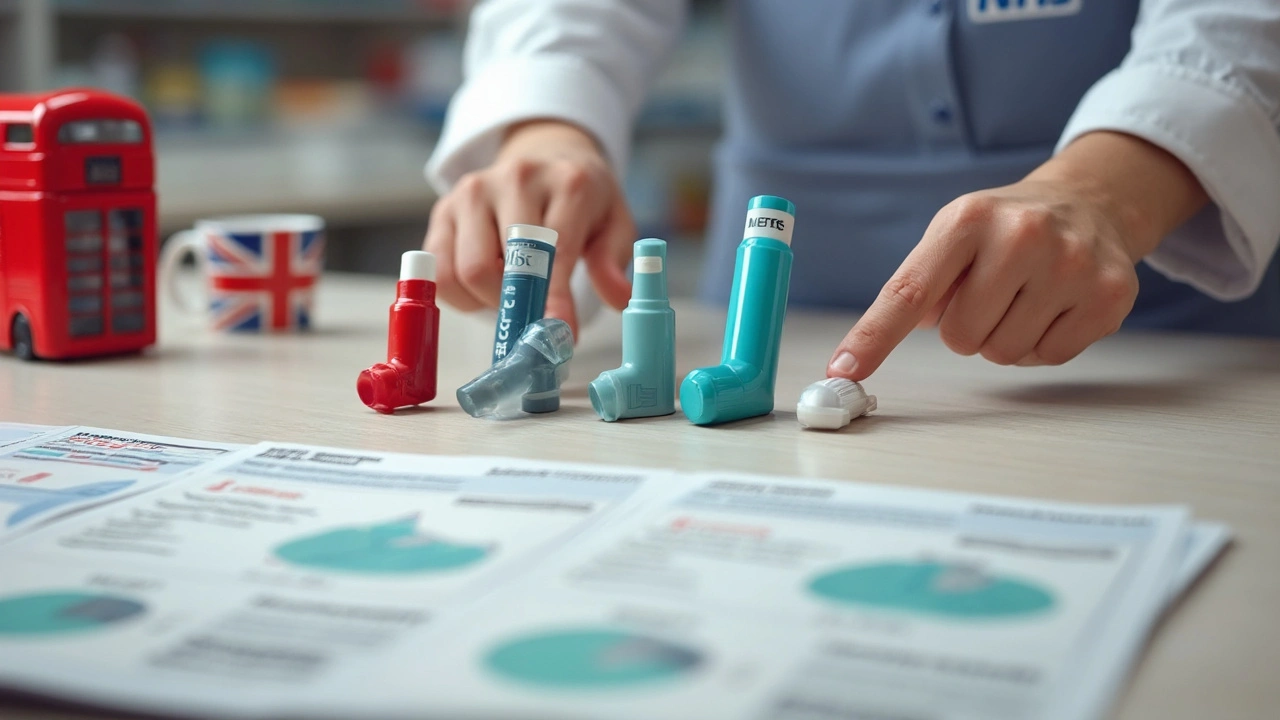How Symbicort Works: The Science Inside and Out
If you pop open a Symbicort inhaler, you’re looking at two drugs—budenoside and formoterol. Together, they’re like a tag team for your lungs. Budesonide fights inflammation, keeping your airways from swelling up and making it harder to breathe. Formoterol, on the other hand, opens up those airways by relaxing the muscles around them. This combo is part of a class called ICS/LABA—short for inhaled corticosteroid and long-acting beta2-agonist.
Just to keep things clear, ICS (inhaled corticosteroids) work long-term to reduce inflammation in the lungs. LABAs (long-acting beta agonists) keep airways open over several hours. The effect? Most people on Symbicort report fewer flare-ups, less wheeze, and a smoother time with everyday activities—like walking the dog or hiking with friends.
Symbicort isn’t the only inhaler with this tag-team approach. Plenty of others use the ICS/LABA blueprint, though they tweak the molecules for sometimes subtle differences. For dosing, doctors typically start adults at two puffs morning and night, but some need higher or lower doses based on how stubborn their symptoms run. Forgetting a dose here and there can mess with symptom control, and for folks with asthma, consistent dosing pays off big when it comes to preventing nasty attacks (no one wants to make a panicked ER run at midnight, trust me).
The safety profile? Most people use Symbicort without drama, though trouble can pop up: throat irritation, hoarseness, shaky hands, or a bit of a racing heartbeat. Rarely, some get fungal infections in the mouth—especially those who skip rinsing after a puff. If you’ve got high blood pressure or heart trouble, talk to your doc: LABA meds can sometimes make those trickier. Some people just don’t do well on this combo—and that’s where the hunt for alternatives gets interesting.
The World Beyond Budesonide/Formoterol: Exploring Similar Medications
If Symbicort isn’t your match, a whole lineup of meds use a similar two-pronged attack. Let’s break down the most popular options, how they work, and what sets them apart from one another.
Fluticasone/Salmeterol (brand name: Advair) is probably Symbicort’s best-known cousin. The big difference? It swaps in fluticasone as the steroid and salmeterol as the bronchodilator. These work like Symbicort—they calm inflammation and keep airways open—but the molecules act at slightly different speeds. Some users say Advair feels milder or kicks in differently. It comes as a disk inhaler (called the Diskus) and as an HFA inhaler. Dosing is usually one puff twice a day, but check the strength on your inhaler: high doses can mean more side effects (like that throat irritation and maybe even some muscle cramps).
Mometasone/Formoterol (brand: Dulera) is another ICS/LABA with its own twist. Mometasone has a reputation for being a gentle steroid with strong lung effects and fewer usual steroid side effects—like thrush or hoarseness. Its partner, formoterol, is the same as in Symbicort, so you get a familiar bronchodilator effect—quick to start and long-lasting. Some people find Dulera easier on their voice; others barely notice a difference.
Fluticasone/Vilanterol (brand: Breo Ellipta) is a once-daily inhaler. The kicker is the ultra-long-acting vilanterol, which lets you go all day on a single puff. It’s a great option for anyone tired of toting an inhaler everywhere or who just can’t stick to a twice-daily routine. The disk-style inhaler feels more high-tech, but it can be a struggle for people with weak grip or limited dexterity.
Formoterol/Aclidinium (brand: Duaklir Pressair) is more popular for COPD than for asthma. Aclidinium is an anticholinergic—it helps by blocking certain signals that clamp down on the lungs. Formoterol jumps in to relax airway muscles. The combo helps clear out sticky secretions and stop sudden “tight chest” moments. Users with COPD who need both bronchodilation and more relaxed, open airways sometimes see better stamina using something like Duaklir.
Maybe you’ve noticed that all of these combos aim to hit two targets: airway inflammation and airway muscle tightening. The differences often come down to how fast one medicine kicks in, how long it lasts, and (for some people) how well it fits daily life. Curious to see more details or compare even more options? This rundown on medications similar to Symbicort gives you a bigger list and more info on how each stacks up—good for those who want to weigh the tradeoffs side-by-side rather than just guess based on advertisements.

Comparing Dosing Schedules and Convenience
When you’re managing chronic asthma or COPD, dosing schedules can become a daily grind. Some inhalers demand twice-daily use on the dot; others make things easier by stretching to once-daily. And yes—convenience often makes the difference between perfect control and yet another flare-up.
Take Symbicort: Most adults start at two puffs in the morning and two at night. Not bad, but miss a dose, and you might notice things get tight. Compare that to Breo Ellipta, which promises full control on a single morning inhale—great for folks who are scatterbrained before their second coffee. Advair splits the difference, with dosing twice a day but both disk and inhaler delivery, which some people like for flexibility.
Manufacturers know that options matter: if you travel a lot, work shifts, or simply struggle to build habits (guilty as charged), a once-daily inhaler is going to feel like a gift. Here’s a quick look at typical dosing versus duration:
| Drug Combo | Brand Name | Dosing Schedule | Duration of Effect |
|---|---|---|---|
| Budesonide/Formoterol | Symbicort | 2x daily | 12 hours |
| Fluticasone/Salmeterol | Advair | 2x daily | 12 hours |
| Fluticasone/Vilanterol | Breo Ellipta | 1x daily | 24 hours |
| Mometasone/Formoterol | Dulera | 2x daily | 12 hours |
The stats above mostly hold steady, but your body might process a med a bit faster or slower, especially depending on genetics, age, or other meds you take.
There’s also the question of inhaler types—some folks love the "whistle" of the Diskus, which lets you know you’re really inhaling, while others prefer the classic press-and-breathe method. If your hands shake or arthritis is kicking in, devices like Breo Ellipta or Pressair may be easier to use. Charlotte, my wife, swears by any inhaler that doesn’t need serious thumb strength—she says the difference is night and day.
Whatever you pick, stick with a routine: asthma doesn’t care if it’s a weekend or a workday, so consistency is your secret weapon.
Side Effect Profiles and What Sets Each Drug Apart
Here’s where things really get personal. Sure, every ICS/LABA combo tries to dodge serious side effects, but different drugs can still feel miles apart—that odd tickle in your throat, the cough, or maybe that wired, jittery feeling you get after a double espresso. It’s not in your head: the molecules genuinely interact with your body in unique ways.
Let’s break down some of the most common and uncommon side effects you might run into:
- Throat irritation and hoarseness: This one’s a classic. Almost every inhaled steroid can hit your voice, especially if you don’t rinse after every puff. Advair might seem milder for some, but if you’re a singer or frequent public speaker, you’ll want to be careful regardless.
- Oral thrush (yeast infection): More common with higher steroid doses. Rinsing and spitting—not swallowing—after inhaler use cuts this risk way down.
- Shakiness and rapid heartbeat: Comes mostly from the LABA part (formoterol, salmeterol, or vilanterol). Symbicort and Dulera are both fast-onset bronchodilators, so some folks feel a bit buzzy shortly after a puff, especially when their bodies aren’t used to it. Usually, this fades in a few weeks, but for some, it never goes away totally.
- Muscle cramps: Rare, but can appear with Advair thanks to salmeterol, particularly at higher doses or with dehydration. Staying hydrated and stretching regularly helps.
- Headaches and insomnia: A few unlucky people find they get headaches or trouble sleeping, especially when taking doses late at night. Try shifting all inhaler use to the morning or early evening if this sounds familiar.
- Long-term risks: We’re talking bone-thinning, slower wound healing, or higher blood pressure—mainly if you’re on high doses for years at a stretch. Most people don’t hit these unless they’re on max strength for a long haul, and regular check-ins with your doctor will catch any issues early.
Don’t forget drug interactions. Certain antifungals, some HIV meds, and even grapefruit juice can mess with these drugs (mainly by changing how steroids are broken down in your liver). If you’re on any other long-term medications, always double-check. For example, one British asthma study in 2023 found that people on both high-dose fluticasone and certain antiretrovirals had double the risk of steroid side effects.
Kids, pregnant folks, and seniors all react a bit differently. Doctors tend to start them on lower doses, watch for growth issues in kids, or check bone health in seniors. The best plan? Custom-fit the inhaler to your needs, lifestyle, and body—not just what’s popular or advertised most.
Another tip: side effects might feel worse at first, especially when switching brands. Give a new med a decent trial (think at least two weeks) before you decide it’s not for you. Sometimes your body just needs time to adapt.


Nick Bercel
May 5, 2025 AT 19:23Also, rinse your mouth. Like, actually. I used to just swallow it. Turns out, that’s how you get thrush. Rookie mistake.
Wilona Funston
May 7, 2025 AT 14:31Naga Raju
May 8, 2025 AT 03:44Ben Finch
May 10, 2025 AT 00:53Paul Avratin
May 11, 2025 AT 23:31Prem Mukundan
May 12, 2025 AT 00:48Jose Lamont
May 13, 2025 AT 03:03Kalidas Saha
May 15, 2025 AT 02:29Jordan Corry
May 15, 2025 AT 16:53Alex Hughes
May 17, 2025 AT 02:13Steve Dugas
May 18, 2025 AT 11:23Ruth Gopen
May 19, 2025 AT 01:21Have you SEEN the side effect profiles??
My cousin’s daughter developed oral candidiasis from Symbicort and had to go on antifungals for SIX WEEKS!!
And now you’re telling me people are STILL choosing it over Dulera??
WHAT IS WRONG WITH YOU PEOPLE??
I’M NOT EVEN MAD-I’M JUST DISAPPOINTED.
Mohamed Aseem
May 20, 2025 AT 18:44Colter Hettich
May 21, 2025 AT 15:44Dan Gut
May 22, 2025 AT 15:48Matt R.
May 24, 2025 AT 15:09Marcus Strömberg
May 26, 2025 AT 14:01Brandi Busse
May 26, 2025 AT 20:49Hubert vélo
May 27, 2025 AT 02:55